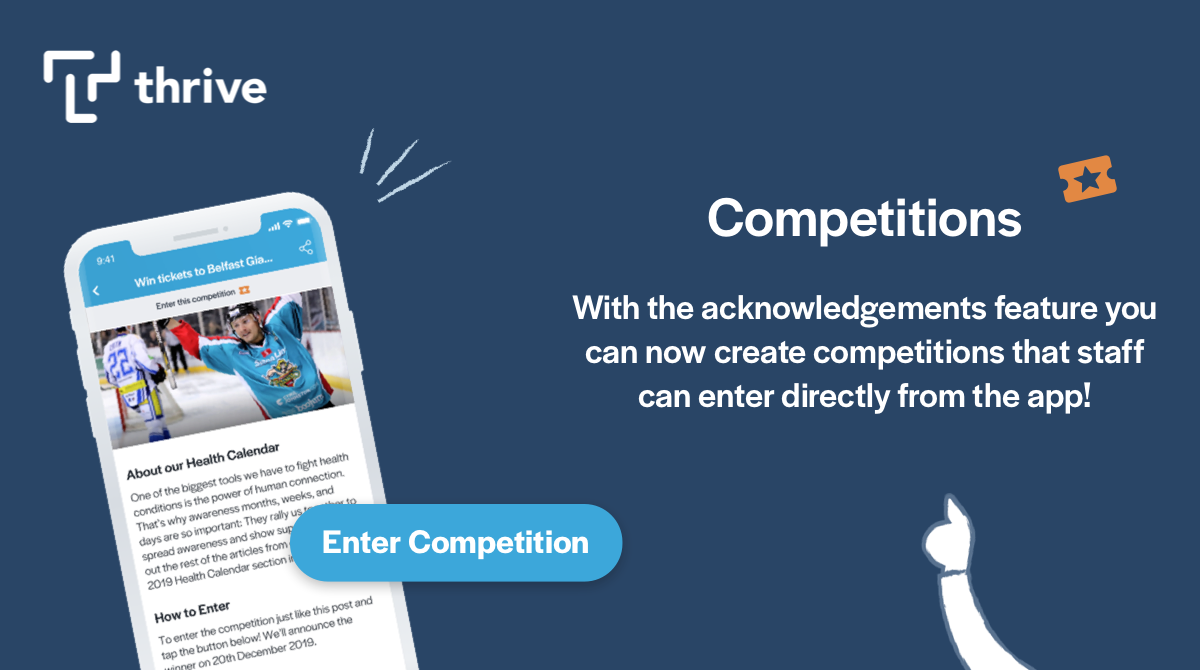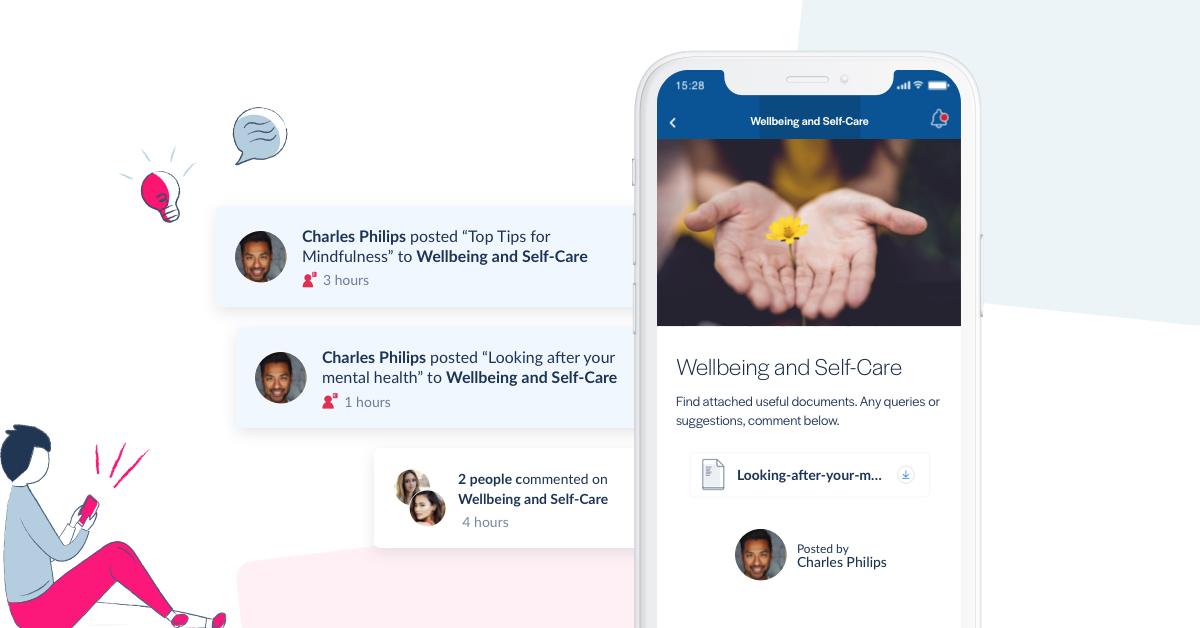COVID-19 hasn't just changed the way we work, it's also changed our priorities, with many now putting health and well-being at the top of the list. Here's how COVID-19 impacted employee well-being and connectivity, and how employers can support their staff.
The world of work now is a very different place than we could have imagined only just a few years ago, with employers and employees adjusting and adapting to the new way of working - during the pandemic, more than 80% of surveyed employees felt the crisis significantly affected their daily work lives.
The pandemic has forced organisations to re-think their employee experience in ways that recognise and respect role differences - from remote desk-based workers to front line, deskless teams.
Employers are adjusting their approaches to the everyday work environment and experience, particularly focusing on employee wellbeing, mental health, inclusion, communication, and connectivity.
Operating in the 'new normal' imposed by COVID-19 has raised a range of issues for organisations world-wide - with one of the biggest challenges being employee connectivity in this new reality of most people now working socially distant or remotely online.
What can you do to help improve your colleague's well-being?
Employee wellbeing is about optimising the health of all employees as well as personal contentment and job satisfaction. It's crucial for employers to understand that a focus on employee wellbeing involves a holistic approach, taking into account the numerous factors shaping how employees feel at and about their work, and considering how as an employer you can influence these for the better.
#1 Managing stress and supporting employees
Stress should be the number one issue for organisations to address, as it can increase the risk of many health conditions.

Organisations can help employees cope with and manage stress through several ways:
Encouraging two-way communication with employees.
Effective communication can reduce stress, by ensuring employees are well-informed to carry out their roles as well as understanding the health and safety policies, goals and values of your organisation. Employees can be encouraged to give feedback through employee surveys, one-to-one or group sessions, idea sharing and collaboration sessions.
Communication, now, should feel personal, relevant, social and add value to the individual in a way that, encourages connectivity and also focuses on their wellbeing and mental health. Communication should be two-way, ensuring employees know they have a voice that's being listened to. The introduction of an employee app, for example can ensure there is a constant flow of information from employer to employee and employee to employer.
.png?width=1200&name=TwoWayCommunication-LinkedIn%20(1).png)
Give employees greater independence, greater responsibility, meaningful and timely feedback.
Showing you trust your employees will reassure them in their role as well as motivating them to take full responsibility for their tasks. Try to avoid checking in on employees too regularly, it's good to find the right balance between being a supportive leader and micromanaging.
Set realistic, inspiring and challenging goals and be sure to clearly communicate these consistently.
Employees must be given feedback on how well they are progressing towards their goals as well as organisational goals, they should also feel comfortable to give their feedback and suggestions on these goals and be encouraged to speak up if they seem unrealistic.
Create a fair distribution of incentives, perks and rewards.
Show appreciation of your employees by recognising and rewarding them when they go above and beyond their duties or complete projects that are challenging, for example, a simple virtual high-five, can give an employee a real sense of acknowledgement of achievement.
Promote a safe and friendly working environment.
Share as much information as possible when it comes to health and safety, during uncertain times, information can help reassure employees. Providing job enrichment and personal growth opportunities can also help. Some industries may even allow for job rotation to continue to motivate and 'Upskill' their teams. Here's how DPD Ireland used their Thrive employee app to provide their employees with easy and equal access to resources, tools and development opportunities.
#2 Fitness, Nutrition, Sleep and Me Time
Three major factors which attribute to wellbeing are fitness, nutrition, and sleep.

Organisations can help encourage healthier teams through several strategies, including:
Healthy competitions and events.
Promoting healthy competitions indirectly encourages the health and wellbeing of your employees. Start off with getting your employees engaged in something like 'Coach to 5K' or virtual yoga or meditation sessions or fitness classes using apps like FiiT over their lunch break or freeing up some time during their day.

Sharing recipes and foodies photos.
Who doesn't love a Foodie photo-wall! Dedicated nutrition section within an employee app perhaps? Get the conversation going with your teams and get employees excited about making nutritious meals for themselves and their family. Share ideas with each other to become more creative in the kitchen. Having a nutritious and balanced diet encourages a healthy immune system, critical for personal health and wellbeing.
Get social.
Photo walls in an employee app, for example, are great for encouraging social interactions, colleagues can post photos of their remote working experience, adventures, hobbies, wall of recipes and other activities. This keeps people engaged and connected with each other. This is also very useful for new employees joining the team to get to know their colleagues on a more personal level, quicker. Some client's have introduced small competitions for the best photograph posted on their app's photo wall which has helped lift spirits, especially during these challenging times.

Sleep.
Sleep is good for: (1) Decreasing stress, (2) improving your mood, (3) enhancing concentration and (4) reducing the risk of chronic illness. With an increasing digital workforce, many employees may feel their sleep is disrupted and even more so since work from home. One factor contributing to lack of sleep could be too much exposure to blue light, which can reduce melatonin levels - particularly if employees are working later hours and struggle to switch off. An increasingly popular method to reduce the exposure to blue light is wearing blue-light blocking glasses, or signing off screens if possible, in the late afternoon, giving enough time to re-adjust before bedtime. Managers and leaders can also be more mindful when it comes to late night emailing, some people grab time in the evenings to catch up on emails, which might work better for them but sending an email to your colleague in the evening can put them under pressure to reply. The simple act of scheduling your evening emails to hit your colleagues inbox in the morning will remove this pressure and help colleagues to really switch off in the evening. When we don't get enough sleep, not only are we more susceptible to stress, but lack of sleep lowers the threshold at which we perceive stress, meaning we're likely to interpret the same situation as more stressful if you've had a late night versus a well rested one. Employers can help by providing information and tips to promote better sleep they could also share links to app like the Calm app which promotes better sleep and meditation or even purchasing Calm subscriptions for their teams.

Promoting the Practice of Mindfulness.
Mindfulness can have a positive impact on mental health and wellbeing. As our lives become increasingly busy, interest in trusted techniques that will bring focus, calm and wellbeing are becoming a popular method for employees to relax and re-charge.

There are several apps and links which employers can share with employees. Organisations can also run their own virtual mindfulness sessions to help strengthen their community and allow employees to re-connect with each other and themselves.

Taking a Break.
With the new way of working, especially the switch from office to home, many employees find themselves missing that space of time, during a commute, for example, that they have to themselves, being aware of this and consciously reminding your colleagues to take this time back will help. Encourage your employees to go for a walk before starting their day or during their lunch.
Encourage teams to meet virtually for some time to pause from work to enjoy a cup of tea or coffee together. Remind colleagues to listen to their favourite song when they feel stressed. Ensure they are making the most of their weekends and avoiding work, getting outdoors and exploring somewhere new can help their minds also. Employees should know that it's OK to take some 'me time' back and should be reminded to encourage their colleagues to do the same. Sharing photos of their free time, new walks or adventures at the weekend can really help employees to keep the personal connections with each other as well as encouraging them to get outdoors.

Read and encourage colleagues to read uplifting books.
There are many great books that can really help with advice on resilience, getting a better work-life balance, managing stress or just giving yourself a mood boost. You may want to start a book club to encourage colleagues to share books that they enjoyed reading. Some books that come to mind are, Thrive: The Third Metric to Redefining Success and Creating a Happier Life by Arianna Huffington, and The Infinite Game by Simon Sinek.
Personal work relationships.
For the most part, people spend the majority of their week in work, normally in close proximity to colleagues. People underestimate the value of these relationships when they are suddenly apart. Team bonding activities can go a long way when it comes to employee engagement and morale. Taking 30 minutes a week to have a fun catch up - i.e. a virtual weekly quiz and regular mini-competitions, can keep employees engaged in your culture and increase positivity. This year companies can also look to moving Christmas parties online and sending care packages to their staff as a thank you. Employers could think to send birthday gifts to employees around the time of their birthday to maintain a positive employee morale. As with business meetings, corporate social activities shouldn’t cease just because you are not together. If you have weekly drinks on a Thursday night, continue that virtually.
#3 Financial Help and Advice
We should remember that everyone is facing a unique experience at the minute. Not all employees are as financially comfortable as they may seem and Covid has definitely raised the levels of uncertainty when it comes to finance for everyone. Employee Assistance Programmes (EAPs), Debt Management support and emergency loans are just some of the ways that employers can help during difficult times.
Other things to consider might be, online budget modellers, a debt counselling service, payroll advances, workplace lending schemes and time off to sort out financial issues. Giving employees the opportunity to reach out to Human Resources for example, could have a serious impact on reducing stress and working together on a plan towards financial stability.
#4 Acknowledgement and Feedback
The continuous sharing of information with your workforce along with encouraging feedback and idea sharing are other ways to engage with employees and increase connectivity.
Feedback.
Start with improving communication by asking employees for their thoughts via a survey or virtual calls, for example, share weekly updates, schedule virtual town-hall meetings , create competitions and keep asking employees to speak up, reminding them that their voice matters and is listened to.
Acknowledge work and personal accomplishments.
This encourages employees and makes them feel valued and appreciated. Employers should also encourage peer-to-peer recognition through virtual high five's which boosts employee morale and allows colleagues to thank each other for their efforts and support. Check out how Derry Group Ireland used their Thrive employee app to show their appreciation for their team while creating some festive cheer at Christmas.
Final Thoughts...
Company culture, leadership, employee experience and the digital workplace are now being put to the test. It’s vital for companies to understand that Covid-19 has had a huge impact on people's wellbeing and mental health as well as how people work and when they are available to work. Appreciating these circumstances and where possible, creating new working arrangements and becoming flexible with your employees will be hugely beneficial to both the employer and the employee.
Organisations should embrace new ways, to create a better way of working that drives a connected culture. The transition to a more digital workplace enables constant, consistent and connected communication, regardless of team structure or location, and those who embrace this will Thrive as we emerge into a 'new' and 'better normal'.
Next Steps...
Are you interested to see how an employee app can help improve employee wellbeing? Let us show you how a Thrive App along with our tried and tested best practices can transform your employee connectivity and wellbeing today.
Did you enjoy reading this post? You may be interested in downloading our eGuide below.
.svg)

-1.png?width=1200&name=CelebrateSuccess-LinkedIN%20(1)-1.png)

